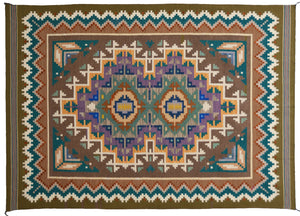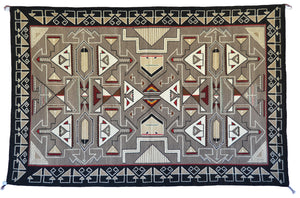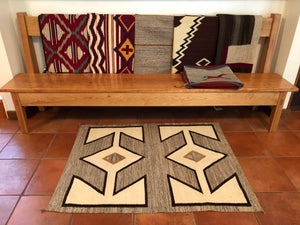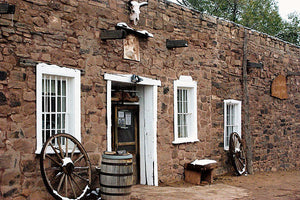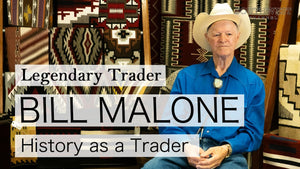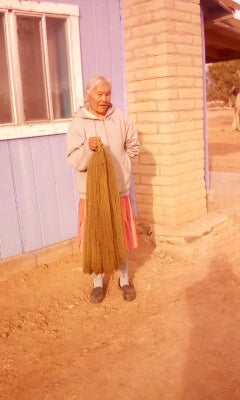Wearable Art

Native American Art Magazine April/May 2019
April 1st, by Susan Sorg
Wearable Art
A look at the Navajo Poncho Serape from its early beginnings through today.
When does clothing go from something worn or put on without thinking, everyday part-of-your-life clothing to becoming something artistic, as in “wearable art”? And, it has a rich history. For those who deal in it or collect it, the answer is easy: something created by a Navajo weaver.
Take the poncho, for example. No, not one of those waterproof ones you see at an outdoor sporting event or even the ones some of us who came of age during the late 60s wore along with our bell-bottomed jeans. Ponchos have been around for centuries, and believed to have originated in South America along the Andes. Spanish conquistadores most likely were the first Europeans to see them on this side of the Atlantic and took them back home. The style also migrated north into Mexico, then further north into what’s now the American southwest.
Scholars generally agree Navajo weaving was likely established in 1650, but wasn’t well known until around 1800. The “Classic” phase is from 1800 to 1865 while “Late Classic” picks up in 1865 and continues until 1880. It’s during the Classic period when Navajo weaving was becoming more prominent, not just among different tribes, but also among U.S. soldiers, traders, cowboys, and other adventurous souls heading west. A poncho created by a Navajo weaver was considered a high-end status symbol.
“A poncho was as expensive as a house back then. It would take a couple years to make,” says Jeff Voracek, owner of Red Mesa Gallery in Penryn, California.
“The highest documented price for a Navajo weaving was allegedly, something in the 1850s that sold for $500,” he adds. “$50 to $100 was what it cost you to get a good blanket. And a poncho would certainly be on the high side of that. It was for the person who could afford it”
Joyce Begay-Foss, the outreach director for the Museum of Indian Arts and Culture in Santa Fe agrees ponchos and other historic wearable items created by Navajo weavers were of high quality.
“Ponchos were made for people as a high trade item, sometimes those in the military, people who served in the infantries traded for them,” she says, adding other weavings such as Chief Blankets, were also highly thought of and sought after.
Two examples of high quality ponchos from the Classic/ Late Classic periods are now thousands of miles apart. One is in Philadelphia, in the University of Pennsylvania Museum of Anthropology and Archeology. Experts believe it was woven approximately 1850, using handspun wool yarn, of white and dark blue, dyed in indigo, as well as bayetta (raveled worsted) which gets its deep red from cochineal. The zig-zag design is often referred to as a snake pattern.

According to William Wierzbowski who is with the museum, the poncho was donated decades ago. “It was gifted to us in 1976 by Ted Newbold, a Philadelphian who was involved in arts and culture,” Wierzbowski writes. “It was part of his first wife’s family summer cottage décor in northern Michigan but I recall him telling me that they had no idea how her family acquired it.”
Meanwhile, back in the southwest another poncho resurfaced only a few years ago, this time in New Mexico. It passed down through a family in Albuquerque, and was brought to the attention of Steve Getzwiller, collector and owner of Nizhoni Ranch Gallery in Sonoita, Arizona. “A picker friend of mine found it, and I got first shot at it even though half a dozen other dealers wanted it,” he explains.

PC 256, Classic Poncho Serape, circa 1860, 55" x 78" - call for pricing
“It’s in absolutely mint condition,” he continues. “And it’s got the same snake pattern as the one in the Philadelphia museum has.” Getzwiller firmly believes his poncho, which he thinks was made in the mid-1860s, came from the same weaver. Others, who have seen only photos of Getzwiller’s weaving, say the similarities are strong, and it could certainly be from the same weaving family.
Gallery owner Jeff Voracek who has handled it says similarities of the two pieces are not by accident. “When you’re that good of a weaver, you wouldn’t be copying anybody else,” he says. “It’s very similar, it’s not a copy whatsoever, and it’s unique. I would call it the fingerprint of the prior weaver.”
Voracek also believes Getzwiller’s poncho could have been made later, more like early 1870s, citing the deep purple used in the piece instead of indigo blue, saying it was a new color for Navajo weavers. “When they got packet dyes, they went wild with them. And packet dyes are there in the (18)70s. So in this blanket that Steve has, it’s got purple bayetta in it, a really fine diameter purple bayetta,” And, Voracek says he has not seen purple in any other weaving like this.
The Classic and Late Classic periods was ripe with other variations of “wearable art”, with dazzling blankets made to be worn with pride. Instead of the Spanish name sarapes, Begay-Foss prefers to call them “shoulder blankets.” These pieces are woven vertically, and created in many, many sizes.
“They have a very fine warp and weft count,” she says. “The piece is so tightly woven, they’re known for warmth and nearly waterproof.” That also added to their durability and value. Who wouldn’t want something which kept you warm and dry through the often harsh and changeable seasons in the higher altitudes of northern New Mexico and Arizona?
“It’s warm. You can sleep with it, you can walk with it, and you can do anything with it on. It was like that,” says master weaver Kathy Marianito. “This was different yarn, thicker yarn, and it makes it a thicker blanket and poncho, and things like that.”
“One thing to remember,” says Joyce Begay-Foss, “this was during the period of the Long Walk, when the government marched the Navajos out, in 1863, and then when they came back in 1868. This was within that time frame. We have these master pieces of weaving…that’s what sustained our people, with these amazing woven pieces.”
The Navajos were literally herded off their lands, walking hundreds of miles to Bosque Redondo in New Mexico. It was a horrific time for them but one in which their culture grew stronger with resolve and ingenuity. The weaving continued, with an assortment of materials such as commercial yarn, which weavers got from the government. They also had bayetta, which is usually commercial cloth and often times flannel which was then unraveled. While bayetta came in virtually every color it was often times red when they got it, or else dyed red with cochineal.
Whatever the material, Navajo pieces made during the Classic and Late Classic years were quite simply stunning. These are the years leading up to the Long Walk, followed by the time at Bosque, and afterwards when weaving of ponchos and wearable blankets increased. A perfect example are Chief Blankets, as praised by scholar Joe Ben Wheat in a 1976 article, when he called it “one of the finest achievements in Navajo weaving.” Simple, and yet made with the best materials to be found by the best weavers, these were expensive and considered a status symbol to own.
“They were woven for people of prominence, Chief Blankets,” says Begay-Foss, who also points out the irony of the name for this type of wearing blankets. “We don’t have chiefs…we have leaders, ‘Nataaniis’.”
One of those early leaders, Manuelito and his wife Juanita, who was a master weaver in her own right, helped in the negotiations to end the time of the Diné, the Navajo people at Bosque. In 1868, the Navajos finally returned to their native lands, becoming one of the few tribes to achieve that. However, this painful exile with the Long Walk remains seared in their history.
It was during this time another type of “wearable art” came to be, and those are blankets, serapes, with a “Spider Woman hole.” Spider Woman is one of the primary deities in the Navajo culture. Legends say it was she who taught the Navajos to weave, and in some of the older blankets in the 19th century, a small slit was left, a hole like in the center of a spider web, to acknowledge what Spider Woman did for the people. Others say the small hole in the center of a blanket, a sarape, had another purpose.
“They used to peek through it, and hide behind and see soldiers when they were coming and what have you,” says Steve Getzwiller. “That’s the story I’ve heard but that’s more in the line with conjecture.”
A Spider Woman hole is in the center of one weaving he’s owned for decades. This serape defies the odds and rules when it comes to determining ages of historic Navajo textiles. Getzwiller says the colors used were those only found at Bosque. And yet the design, with serrate prominent on the diagonal stripes, is thought to have originated much later.

PC 258, Serape Blanket, 3 ply Saxony with natural dyes - call for pricing
Getzwiller says some of the weaving is done with 3-ply Saxony yarn, again something usually found in Late Classic. There’s also two shades of red, out of 4-ply yarn, as Voracek discovered…and that’s not all.
“When you have something with 4-ply in it, that would typically be 1880s,” Voracek says. “But he happens to have one that has two shades of 4-ply and one’s a red and one’s more of a pinker red, and they’ve both been tested twice as cochineal….and cochineal stops in the 1870’s.”
Then there’s the design, serrate, or knife edge, the diagonal stripes which come to a point and was usually seen in the 1870s or later. “There were pieces collected at Massacre Cave that had serrate on it,” Voracek continues. “That was close to (the year) 1800, so we know they had the ability to do them…but most of the time they didn’t.”
Voracek also remembers a conversation he had with Steve Getzwiller giving yet another element to the legends behind adding a Spider Woman hole to weavings.
“It’s purported by Steve, from talking to relatives of Bosque survivors that it was something they incorporated if they have survived Bosque,” Voracek says. “If they had went through Bosque, or during or right after, when you see the Spider Woman holes that was like a statement: ‘I was there. I survived it.’”
Voracek also believes there to be far fewer weavings with Spider Woman holes than there are actual ponchos which have survived this long. Ironically, Navajo woven ponchos are starting to come back, and it’s through the great-great granddaughter of Manuelito and Juanita: Kathy Marianito, who says some of the designs were passed down to her.
“The design,” she says, “I had to wait for it, and I don’t want anyone to copy it.”
Serape Poncho Navajo Weaving : Kathy Marianito : Churro 1450 : 35″ x 60″
“The silk wool blend piece that Kathy did, it’s the first poncho serape to come off a Navajo loom in 100 years,” says Getzwiller, taking about a poncho Marianito wove a few years ago with Spider Woman crosses on it.

Marianito, who says she gets many of her designs from her dreams, points out how anyone can get a jacket in a store. “They’re machine made, even the way they color it now, and it’s the yarn, machine yarn. They use our designs now, even the moccasins, paper towels, design on it.”
But to weave something you wear? Now that brings joy, along with pride to the weaver. It is part of Marianito’s DNA, her family tree going back to Juanita, much like designs of earlier weavings carried down into future ones which she still dreams of.
“That’s the way I am,” she says. “It makes me happy and makes me proud of myself. I love to do that…I don’t know how to describe it any (other) way.”
“That was my dream,” she continues, “something that I’m going to make, and make it into a magazine, or something that I made to look at. Someday they’re going to look at it, and then my grand kids are going to say ‘This is my grandmother’s. She made it like this’ and they’ll carry it on.”
- Beth Barth


